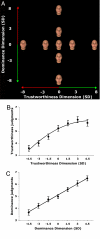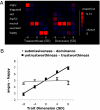The functional basis of face evaluation
- PMID: 18685089
- PMCID: PMC2516255
- DOI: 10.1073/pnas.0805664105
The functional basis of face evaluation
Abstract
People automatically evaluate faces on multiple trait dimensions, and these evaluations predict important social outcomes, ranging from electoral success to sentencing decisions. Based on behavioral studies and computer modeling, we develop a 2D model of face evaluation. First, using a principal components analysis of trait judgments of emotionally neutral faces, we identify two orthogonal dimensions, valence and dominance, that are sufficient to describe face evaluation and show that these dimensions can be approximated by judgments of trustworthiness and dominance. Second, using a data-driven statistical model for face representation, we build and validate models for representing face trustworthiness and face dominance. Third, using these models, we show that, whereas valence evaluation is more sensitive to features resembling expressions signaling whether the person should be avoided or approached, dominance evaluation is more sensitive to features signaling physical strength/weakness. Fourth, we show that important social judgments, such as threat, can be reproduced as a function of the two orthogonal dimensions of valence and dominance. The findings suggest that face evaluation involves an overgeneralization of adaptive mechanisms for inferring harmful intentions and the ability to cause harm and can account for rapid, yet not necessarily accurate, judgments from faces.
Conflict of interest statement
The authors declare no conflict of interest.
Figures



References
-
- McNeill D. The Face. Brown, Boston: Little; 1998. pp. 165–169.
-
- Lombroso C. Criminal Man. Durham, NC: Duke UnivPress; 2006. p. 51.
-
- Hassin R, Trope Y. Facing faces: Studies on the cognitive aspects of physiognomy. J Pers Soc Psychol. 2000;78:837–852. - PubMed
-
- Todorov A, Mandisodza AN, Goren A, Hall CC. Inferences of competence from faces predict election outcomes. Science. 2005;308:1623–1626. - PubMed
Publication types
MeSH terms
LinkOut - more resources
Full Text Sources
Other Literature Sources

